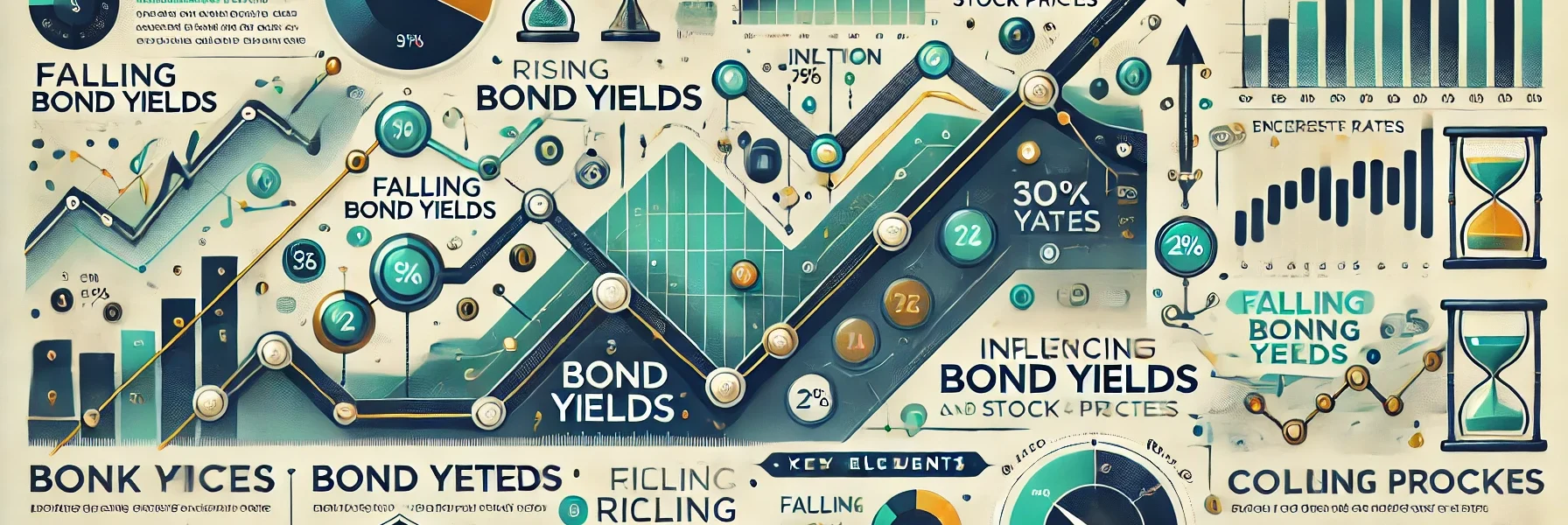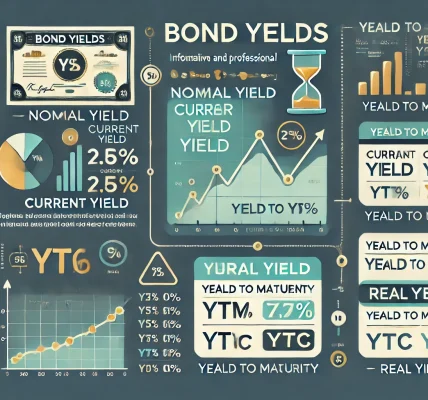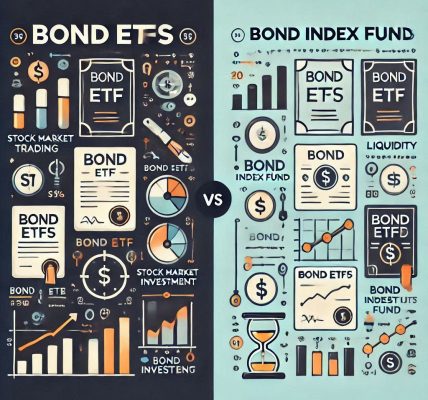The financial world is an intricate web where changes in one market often trigger ripples across others. One of the most significant relationships in the investment landscape is the connection between bond yields and stock market movements. Understanding this relationship is crucial for investors aiming to make informed decisions and balance their portfolios effectively.
In this article, we will explore the dynamics between bond yields and stock prices, discuss the key factors influencing these movements, and provide insights into how investors can navigate this complex relationship.
Understanding Bond Yields
A bond yield refers to the return an investor earns by holding a bond until maturity. There are different types of yields, but the most commonly referenced is the yield to maturity (YTM), which reflects the total return anticipated if the bond is held until it matures.
Types of Bond Yields:
- Nominal Yield: The bond’s coupon rate (fixed annual payment) as a percentage of its face value.
- Current Yield: Annual coupon payment divided by the current market price of the bond.
- Yield to Maturity (YTM): The total return expected if the bond is held until it matures, including all coupon payments and any capital gains or losses.
Bond yields fluctuate based on various factors, including interest rates, inflation, and market demand. This fluctuation directly impacts the broader financial ecosystem, including the stock market.
The Inverse Relationship Between Bond Yields and Prices
When bond yields rise, bond prices fall, and vice versa. This inverse relationship is due to the fixed nature of bond payments:
- Rising Yields: Existing bonds with lower interest rates become less attractive, causing their prices to fall.
- Falling Yields: Existing bonds with higher interest rates become more attractive, increasing their prices.
How Bond Yields Influence the Stock Market
1. Interest Rate Expectations
Bond yields are closely tied to central bank interest rates, such as the U.S. Federal Reserve’s policy rate. Rising bond yields often indicate expectations of higher interest rates, which can increase borrowing costs for companies and consumers.
- Higher Bond Yields: Make financing more expensive, reducing corporate profits and leading to a decline in stock prices.
- Lower Bond Yields: Make borrowing cheaper, stimulating business expansion and potentially boosting stock prices.
2. Investment Alternatives
Investors are constantly weighing risk versus reward across asset classes. When bond yields rise, fixed-income securities become more attractive relative to stocks.
- High Bond Yields: Encourage investors to shift from riskier equities to safer bonds, leading to a potential stock market decline.
- Low Bond Yields: Push investors toward the stock market in search of higher returns.
3. Economic Sentiment
Bond yields reflect broader economic conditions. Rising yields can signal confidence in economic growth, while falling yields may indicate concerns about a slowdown.
- Rising Yields: Suggest strong economic activity but may hurt high-growth or debt-heavy sectors.
- Falling Yields: Reflect caution or pessimism about future growth, which may benefit defensive stocks.
Historical Examples of Bond Yields Impacting Stock Markets
1. The 2008 Financial Crisis:
During the Great Recession, bond yields fell sharply as investors sought safety. This coincided with a massive stock market decline, as economic fears outweighed low borrowing costs.
2. The 2013 Taper Tantrum:
When the Federal Reserve hinted at reducing bond purchases (quantitative easing), bond yields spiked, causing volatility and a brief stock market sell-off.
3. The Post-Pandemic Rebound (2021-2022):
As the economy recovered from COVID-19, bond yields rose on inflation fears, leading to pressure on high-growth technology stocks.
Key Factors Influencing Bond Yields and Stock Prices
1. Inflation Expectations:
- Rising inflation erodes bond returns and often leads to higher yields.
- Persistent inflation can weigh on stock valuations by increasing costs and reducing consumer purchasing power.
2. Monetary Policy:
- Central banks control short-term interest rates, directly affecting bond yields.
- Tightening policies (rate hikes) push yields higher and can slow economic growth.
3. Geopolitical Events:
- Crises or uncertainties often push investors toward safe-haven assets like bonds, lowering yields.
- Stability and economic optimism may increase yields as capital flows into riskier assets.
4. Market Sentiment:
- Investor perceptions about future growth, inflation, and policy changes drive both bond and stock market dynamics.
Strategies for Investors: Navigating Bond Yields and Stock Markets
1. Diversification:
Maintain a balanced portfolio across asset classes (stocks, bonds, and alternatives) to reduce exposure to any single market movement.
2. Monitoring Yield Curves:
Analyze the yield curve (a graph showing yields across different maturities) for signals about future economic conditions:
- Normal Yield Curve: Signals growth.
- Inverted Yield Curve: May indicate a recession.
3. Sector Rotation:
Adjust your equity exposure based on bond yield trends:
- Rising Yields: Favor financials and industrials.
- Falling Yields: Favor utilities and consumer staples.
4. Fixed-Income Allocation:
Consider varying your bond exposure based on yield movements:
- Rising Yields: Short-duration bonds mitigate price declines.
- Falling Yields: Long-duration bonds offer greater price appreciation.
5. Risk Management:
Stay vigilant about macroeconomic indicators and maintain liquidity to capitalize on market fluctuations.
Legal Disclaimer and Compliance Considerations
When discussing financial topics like bond yields and stock market movements, it’s essential to provide clear legal disclosures and avoid making definitive financial advice.
Important Disclaimer: “This content is for informational purposes only and does not constitute financial, investment, or legal advice. Always consult with a qualified financial advisor before making any investment decisions. Past performance is not indicative of future results.”
Conclusion: Understanding the Bond Yield and Stock Market Relationship
The connection between bond yields and stock market movements is a vital aspect of investment strategy. While rising yields can pressure equities through higher borrowing costs and increased competition, falling yields often provide a tailwind for stocks by reducing financing expenses and encouraging risk-taking.
Investors who grasp these relationships, monitor macroeconomic signals, and diversify their portfolios are better positioned to navigate changing market conditions effectively. By staying informed and adjusting strategies in response to bond yield movements, you can make more confident investment decisions in an ever-evolving financial landscape.




